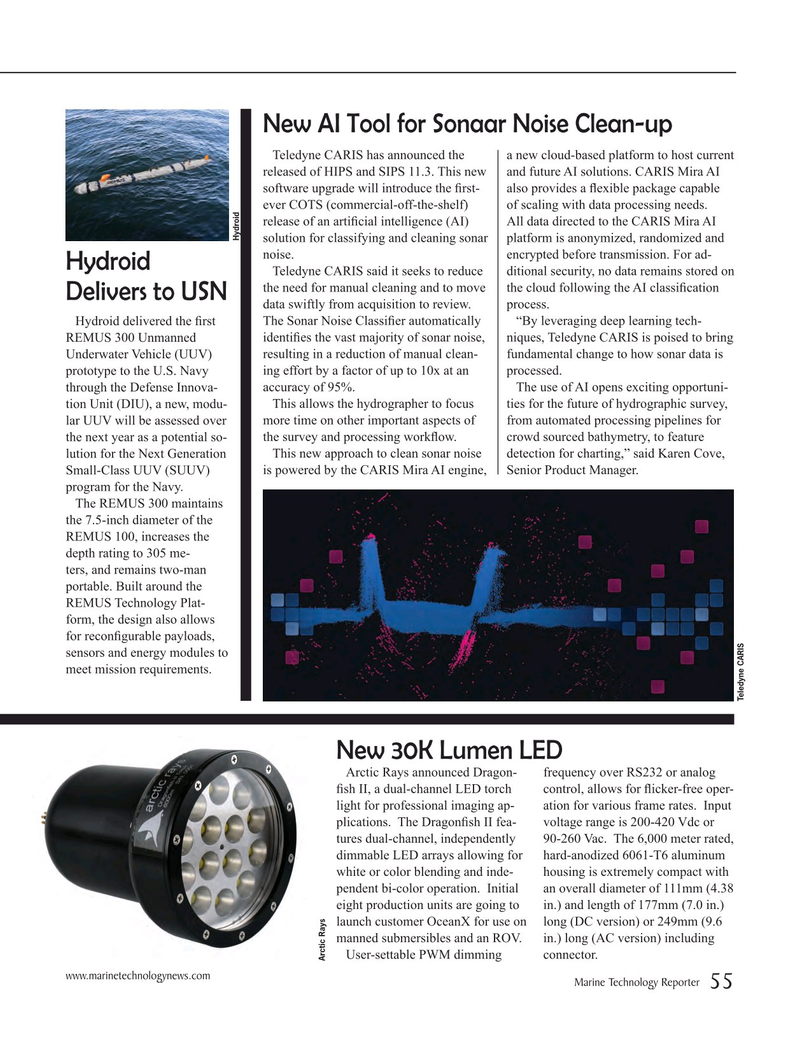
Page 55: of Marine Technology Magazine (March 2020)
Read this page in Pdf, Flash or Html5 edition of March 2020 Marine Technology Magazine
New AI Tool for Sonaar Noise Clean-up
Teledyne CARIS has announced the a new cloud-based platform to host current released of HIPS and SIPS 11.3. This new and future AI solutions. CARIS Mira AI software upgrade will introduce the ? rst- also provides a ? exible package capable ever COTS (commercial-off-the-shelf) of scaling with data processing needs. release of an arti? cial intelligence (AI) All data directed to the CARIS Mira AI
Hydroid solution for classifying and cleaning sonar platform is anonymized, randomized and noise. encrypted before transmission. For ad-
Hydroid
Teledyne CARIS said it seeks to reduce ditional security, no data remains stored on the need for manual cleaning and to move the cloud following the AI classi? cation
Delivers to USN data swiftly from acquisition to review. process.
Hydroid delivered the ? rst The Sonar Noise Classi? er automatically “By leveraging deep learning tech-
REMUS 300 Unmanned identi? es the vast majority of sonar noise, niques, Teledyne CARIS is poised to bring
Underwater Vehicle (UUV) resulting in a reduction of manual clean- fundamental change to how sonar data is prototype to the U.S. Navy ing effort by a factor of up to 10x at an processed. through the Defense Innova- accuracy of 95%. The use of AI opens exciting opportuni- tion Unit (DIU), a new, modu- This allows the hydrographer to focus ties for the future of hydrographic survey, lar UUV will be assessed over more time on other important aspects of from automated processing pipelines for the next year as a potential so- the survey and processing work? ow. crowd sourced bathymetry, to feature lution for the Next Generation This new approach to clean sonar noise detection for charting,” said Karen Cove,
Small-Class UUV (SUUV) is powered by the CARIS Mira AI engine, Senior Product Manager.
program for the Navy.
The REMUS 300 maintains the 7.5-inch diameter of the
REMUS 100, increases the depth rating to 305 me- ters, and remains two-man portable. Built around the
REMUS Technology Plat- form, the design also allows for recon? gurable payloads, sensors and energy modules to meet mission requirements.
Teledyne CARIS
New 30K Lumen LED
Arctic Rays announced Dragon- frequency over RS232 or analog ? sh II, a dual-channel LED torch control, allows for ? icker-free oper- light for professional imaging ap- ation for various frame rates. Input plications. The Dragon? sh II fea- voltage range is 200-420 Vdc or tures dual-channel, independently 90-260 Vac. The 6,000 meter rated, dimmable LED arrays allowing for hard-anodized 6061-T6 aluminum white or color blending and inde- housing is extremely compact with pendent bi-color operation. Initial an overall diameter of 111mm (4.38 eight production units are going to in.) and length of 177mm (7.0 in.) launch customer OceanX for use on long (DC version) or 249mm (9.6 manned submersibles and an ROV. in.) long (AC version) including
User-settable PWM dimming connector.
Arctic Rays www.marinetechnologynews.com
Marine Technology Reporter 55
MTR #2 (50-63).indd 55 MTR #2 (50-63).indd 55 2/27/2020 9:24:59 AM2/27/2020 9:24:59 AM

 54
54

 56
56
